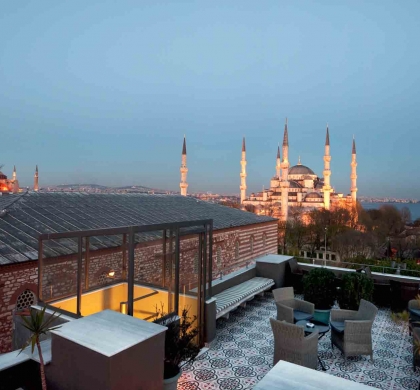Buy or gift a stand-alone digital subscription and get unlimited access to dozens of back issues for just £18.99 / $18.99 a year.
Please register at www.exacteditions.com/digital/cornucopia with your subscriber account number or contact subscriptions@cornucopia.net
Buy a digital subscription Go to the Digital EditionAndrew Finkel looks back on happy days roaming with Bob
Bob Ousterhout’s brain was gargantuan
Of bad puns he was truly the champion
From Champaign to Punjab
The expert was Bob
On anything built in Byzantium
If the above seems a less than reverential encomium for someone colleagues describe as the most important scholar of Byzantine architecture of his generation, Robert Ousterhout has only himself to blame.
Yes, he transformed not just Byzantine studies but also the way architectural historians of other places and of other periods “read” buildings and the use of space. His scholarly output – book after seminal book – seemed the work of an entire institute, not one man. He served his students and his profession long and well: he was president of the US National Committee for Byzantine Studies and the Byzantine Studies Association of North America, and he headed the University of Pennsylvania’s Center for Ancient Studies.
In tribute to his memory, some will reopen his masterly Master Builders of Byzantium. Others might relive, through YouTube, the spectacle of him guiding Martha Stewart in a hot-air balloon over the Cappadocia he understood so well. But all of us touched by his life are powerless not to recall his giggle.
To be fair, it was more a slow, rumbling chortle, one that threatened to erupt into a snort. The cause of his merriment was usually one of his own puns or (on special occasions) a limerick. Bob had carte blanche to laugh at his own jokes since they were invariably very funny or very silly and sometimes both. It was Bob who honoured the retirement of the eminent architect working on Ayasofya at Dumbarton Oaks with an amended rendition of the South Pacific ditty ‘There Is Nothing Like a Dome.’
Even when po-faced, Bob was a brilliant communicator and a much-revered teacher. His writing (he was a frequent contributor to this magazine) drew non-specialists effortlessly into the world of Byzantine studies. He had a rare feel for the fabric of Constantinople but he also followed the trajectory of the city into Ottoman and Republican times. He wrote with great clarity, even when tackling complex questions on why, for example, medieval architecture followed different paths in East and West.
His interests were diverse, from the tattoos of medieval pilgrims to the recklessness of modern-day restoration. Above all, he sparked a revolution by merging social and architectural history, and indeed archaeology, and by bringing material culture to the fore of what had been largely text-based Byzantine studies.
“He saw construction as a series of choices,” explained Charlotte Roueché, Professor Emirita of Digital Hellenic Studies at King’s College London. His interest in people, the quality which made him such a warm-hearted friend, informed the questions he asked of building and landscape. Who built what, why, and for whom, and how did this change over time? The answers lay encrypted in every brick, tie and arch he spent a lifetime examining.
If actually spending time in the field seems obvious now, it was iconoclastic when Bob entered it in the early 1980s, a paradigm shift we have come to take for granted. A summary of his method – almost a manifesto – surfaces in the introduction
to his Eastern Medieval Architecture: The Building Traditions of Byzantium and Neighboring Lands (a book that in 2021 would earn him the Haskins Medal, the Medieval Academy of America’s highest award):
“Although a variety of texts survive, buildings often constitute our primary surviving evidence for reconstructing or re-imagining the culture that produced them. We are thus obliged to learn all we can about them, beginning with their physical structure, closely observed – that is, to ‘read’ the fabric of the building with the same insight and nuance that a philologist would apply to the study of a text. If we are to understand what buildings mean and how they communicate, we must begin with their grammar, vocabulary, and syntax.”
Bob’s doctoral work for the University of Illinois at Urbana-Champaign was on the Chora Monastery in Istanbul (Kariye Camii). Between 1983 and 2006 he went on to teach at Urbana-Champaign, where he spread his wings from mainland Greece to Jerusalem. Ivan Drpić, Bob’s successor at the University of Pennsylvania (where Bob was to hold a professorship for another ten years) stressed the importance of this early work. Chora taught him “to look for aesthetic intent and functional logic behind what might appear at first as an architectural oddity… to view and understand buildings as dynamic, ever-changing entities, constantly in the process of becoming”.
“A church is never just a church,” Bob wrote. His ability to commune with the architecture he studied was particularly evident in his work on Cappadocia, for which, unlike the grand edifices of Constantinople, there is little textual evidence. Drpić describes Bob’s work there as “transformational”. By seeing the wood for the trees, as an entire community replete with secular buildings rather than as ensemble of individual churches, he challenged the orthodoxy that Cappadocia settlements were primarily monastic. For an entire decade Bob, alongside Tolga Uyar of Nevşehir Hacı Bektaş University, ran an on-site summer field school, Cappadocia in Context, which became a training ground for an international generation of Byzantine architectural historians.
If the cuckoo is the harbinger of spring, an email from Bob offering a complex schedule of opportunities to catch him for dinner was the first inkling of summer for Istanbul friends. It was efficient, not officious – the only the way we could get to see him and also be assured he that would get those next chapters done. Occasionally friends were able to mix work and play – such as an impromptu reconnoitre of the woodlands above a military base up the Bosphorus in search of the lost Mavro Molos Monastery. To the best of my knowledge the monastery remains lost, even after we returned with a friend’s motorboat to see if we could spy it from the water. Bob was, among other things, a strong swimmer, so the afternoon was not a total loss.
Bob’s belief that the life of Byzantine buildings did not end with Byzantium translated into an empathy and a sense of responsibility for their preservation, along with concern over the damage that could be done by restoring construction to an arbitrarily fixed point in time. In a Turkey where cultural heritage was becoming the handmaiden of tourism, such criticism meant treading on eggshells.
My first contact with Bob was over a story I did for The Economist in the early 1990s over the Disneyfication of Istanbul’s Theodosian Land Walls, where layers of new cement had interfered with the statics. He was not particularly grateful to me for quoting his complaint that an edifice that had survived nearly 1,600 years might not make it to the end of the decade. But in a curious way it also cemented our friendship. He was in, and often out, of favour with those granting permission to survey and restore historical buildings – particularly as at different times in past years Byzantium was a period the authorities were happy to airbrush out.
I recall roaming with Bob over the rooftops of Istanbul’s Pantocrator complex (Zeyrek Camii) when he, along with a team from Istanbul Technical University, was busy trying to rescue the building from earlier misrepairs that were threatening not just the interior decoration but the entire structure of so important a 12th-century building. At the same time they were focusing on what is so often neglected in the renovation of important sites: doing the archaeology, reading the building, discovering, for example, reused 4th-century bricks whose stamps suggested that in the age of Constantine it had been a Roman estate. I also recall witnessing his heartbreak when a series of political machinations wrested responsibility for the site away from his team, with a new lead roof only half on. “We have been forced to leave the building in a worse state than when we started,” I quoted him saying, in The Times.
I speculate that it was this sort of disappointment which led Bob to empathise with someone like John Henry Haynes, whom he dubbed “the father of archaeological photography” (see Cornucopia 44). Haynes had photographed important sites throughout Anatolia and the Near East – including
the first images of Cappadocia – and had himself been responsible for some remarkable finds, including 17,000 cuneiform tablets at Nippur. Haynes died in 1910, a broken man, after the professor of Assyriology at Penn, Hermann Hilprecht, stole credit for his discoveries. Bob had chanced upon the unpublished photos in the University of Pennsylvania Museum of Archaeology and Anthropology and in typical fashion wondered about the
man behind the lens. A century after Haynes’s death Bob was able to reconstruct his story and his reputation.
Bob celebrated yet another unsung academic luminary, albeit one of his own creation, in his novel To the East, a ripping turn-of-the-century saga of war and archaeology, whose protagonist, a woman in a man’s world, is denied the recognition she deserves.
Bob, too, may have faced uphill battles, establishing a career at a time when openly gay men were not always welcome in corridors of academic power. In this regard, too, he was a trailblazer. Happily, his legacy cannot be obscured. His quality as a mentor and scholar was rivalled only by his quality as a friend. Or, to put it terms of which I hope he would have approved:
We cherish the memory of Bob Ousterhout
Of rupestrian churches he knew a lot.
Sites sacerdotal
In Constantinople
Were toots on the flute of Bob Ousterhout
Robert G Ousterhout,
b. Pendleton, Oregon, January 16, 1950,
d. Philadelphia, April 23, 2023





Cornucopia works in partnership with the digital publishing platform Exact Editions to offer individual and institutional subscribers unlimited access to a searchable archive of fascinating back issues and every newly published issue. The digital edition of Cornucopia is available cross-platform on web, iOS and Android and offers a comprehensive search function, allowing the title’s cultural content to be delved into at the touch of a button.
Digital Subscription: £18.99 / $18.99 (1 year)
Subscribe now